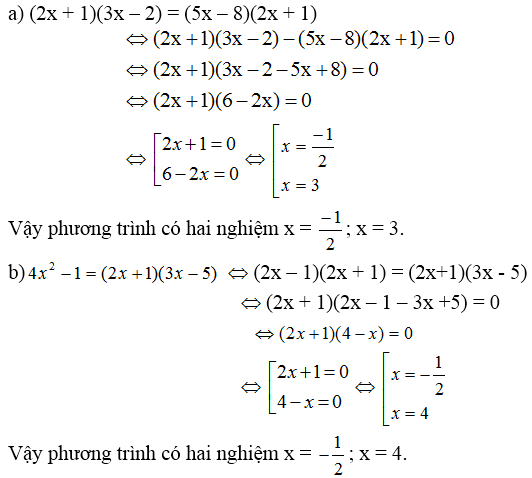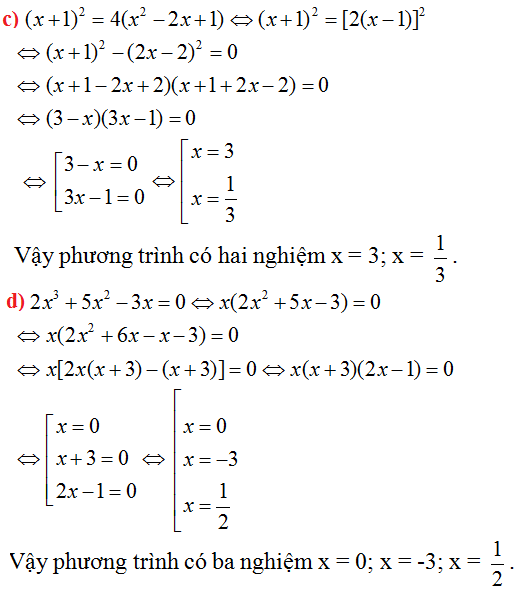Hãy nhập câu hỏi của bạn vào đây, nếu là tài khoản VIP, bạn sẽ được ưu tiên trả lời.

a) đặt \(\left(x^2+x\right)\)là \(y\)
ta có: \(3y^2-7y+4\)\(=0\)
<=>\(\left(3y-4\right)\left(y-1\right)=0\)
còn lại bạn tự xử nhé

chẳng ai giải, thôi mình giải vậy!
a) Đặt \(y=x^2+4x+8\),phương trình có dạng:
\(t^2+3x\cdot t+2x^2=0\)
\(\Leftrightarrow t^2+xt+2xt+2x^2=0\)
\(\Leftrightarrow t\left(t+x\right)+2x\left(t+x\right)=0\)
\(\Leftrightarrow\left(2x+t\right)\left(t+x\right)=0\)
\(\Leftrightarrow\left(2x+x^2+4x+8\right)\left(x^2+4x+8+x\right)=0\)
\(\Leftrightarrow\orbr{\begin{cases}x=-2\\x=-4\end{cases}}\)vậy tập nghiệm của phương trình là:S={-2;-4}
b) nhân 2 vế của phương trình với 12 ta được:
\(\left(6x+7\right)^2\left(6x+8\right)\left(6x+6\right)=72\)
Đặt y=6x+7, ta được:\(y^2\left(y+1\right)\left(y-1\right)=72\)
giải tiếp ra ta sẽ được S={-2/3;-5/3}
c) \(\left(x-2\right)^4+\left(x-6\right)^4=82\)
S={3;5}
d)s={1}
e) S={1;-2;-1/2}
f) phương trình vô nghiệm

Nhìn sơ qua thì thấy bài 3, b thay -2 vào x rồi giải bình thường tìm m
Bài 2:
a) \(x+x^2=0\)
\(\Leftrightarrow x\left(x+1\right)=0\)
\(\Leftrightarrow\hept{\begin{cases}x=0\\x+1=0\end{cases}}\)\(\Leftrightarrow\hept{\begin{cases}x=0\\x=0-1\end{cases}}\)\(\Leftrightarrow\hept{\begin{cases}x=0\\x=-1\end{cases}}\)
b) \(0x-3=0\)
\(\Leftrightarrow0x=3\)
\(\Rightarrow vonghiem\)
c) \(3y=0\)
\(\Leftrightarrow y=0\)

a) Ta thấy x - 1 \(\ne\)0 vì x = 1 không nghiệm đúng phương trình
Nhân hai vế của phương trình với x - 1 \(\ne\)0 ta được x5 -1 = 0 hay x = 1 ,không thỏa mãn điều kiện trên .
Vậy phương trình vô nghiệm .
b) Ta có : \(\frac{\left(x-2\right)^2}{3}-\frac{\left(2.x-3\right).\left(2.x+3\right)}{8}+\frac{\left(x-4\right)^2}{6}\)
<=> 3.(x-2)2 - 3. ( 2.x - 3 ) . ( 2.x + 3 )+ 4. ( x-4 )2 = 0
<=> 3. ( x - 4.x + 4 ) - 3. ( 4.x2 -9 ) + 4. ( x2 -8.x + 16 ) = 0
<=> -5.x2 -44.x + 103 = 0
<=> \(\orbr{\begin{cases}x=\frac{-22+3\sqrt{111}}{5}\\x=\frac{-22-3\sqrt{111}}{5}\end{cases}}\)
Vậy \(\orbr{\begin{cases}x=\frac{-22+3\sqrt{111}}{5}\\x=\frac{-22-3\sqrt{111}}{5}\end{cases}}\)
a) Ta thấy x - 1 \(\ne\)0 vì x = 1 không nghiệm đúng phương trình
Nhân hai vế của phương trình với x - 1 \(\ne\)0 ta được x5 -1 = 0 hay x = 1 ,không thỏa mãn điều kiện trên .
Vậy phương trình vô nghiệm .
b) Ta có : \(\frac{\left(x-2\right)^2}{3}-\frac{\left(2.x-3\right).\left(2.x+3\right)}{8}+\frac{\left(x-4\right)^2}{6}\)
<=> 3.(x-2)2 - 3. ( 2.x - 3 ) . ( 2.x + 3 )+ 4. ( x-4 )2 = 0
<=> 3. ( x - 4.x + 4 ) - 3. ( 4.x2 -9 ) + 4. ( x2 -8.x + 16 ) = 0
<=> -5.x2 -44.x + 103 = 0
<=> \(\orbr{\begin{cases}x=\frac{-22+3\sqrt{111}}{5}\\x=\frac{-22-3\sqrt{111}}{5}\end{cases}}\)
Vậy \(\orbr{\begin{cases}x=\frac{-22+3\sqrt{111}}{5}\\x=\frac{-22-3\sqrt{111}}{5}\end{cases}}\)

a)(2x+1)(3x-2)=(5x-8)(2x+1)
⇔(2x+1)(3x-2)-(5x-8)(2x+1)=0
⇔(2x+1)(3x-2-5x+8)=0
⇔(2x+1)(-2x+6)=0
⇔2x+1=0 hoặc -2x+6=0
1.2x+1=0⇔2x=-1⇔x=-1/2
2.-2x+6=0⇔-2x=-6⇔x=3
phương trình có 2 nghiệm x=-1/2 và x=3

Bài 3:
a) \(\left(x-6\right).\left(2x-5\right).\left(3x+9\right)=0\)
\(\Leftrightarrow\left(x-6\right).\left(2x-5\right).3.\left(x+3\right)=0\)
Vì \(3\ne0.\)
\(\Leftrightarrow\left[{}\begin{matrix}x-6=0\\2x-5=0\\x+3=0\end{matrix}\right.\Leftrightarrow\left[{}\begin{matrix}x=6\\2x=5\\x=-3\end{matrix}\right.\Leftrightarrow\left[{}\begin{matrix}x=6\\x=\frac{5}{2}\\x=-3\end{matrix}\right.\)
Vậy phương trình có tập hợp nghiệm là: \(S=\left\{6;\frac{5}{2};-3\right\}.\)
b) \(2x.\left(x-3\right)+5.\left(x-3\right)=0\)
\(\Leftrightarrow\left(x-3\right).\left(2x+5\right)=0\)
\(\Leftrightarrow\left[{}\begin{matrix}x-3=0\\2x+5=0\end{matrix}\right.\Leftrightarrow\left[{}\begin{matrix}x=3\\2x=-5\end{matrix}\right.\Leftrightarrow\left[{}\begin{matrix}x=3\\x=-\frac{5}{2}\end{matrix}\right.\)
Vậy phương trình có tập hợp nghiệm là: \(S=\left\{3;-\frac{5}{2}\right\}.\)
c) \(\left(x^2-4\right)-\left(x-2\right).\left(3-2x\right)=0\)
\(\Leftrightarrow\left(x^2-2^2\right)-\left(x-2\right).\left(3-2x\right)=0\)
\(\Leftrightarrow\left(x-2\right).\left(x+2\right)-\left(x-2\right).\left(3-2x\right)=0\)
\(\Leftrightarrow\left(x-2\right).\left(x+2-3+2x\right)=0\)
\(\Leftrightarrow\left(x-2\right).\left(3x-1\right)=0\)
\(\Leftrightarrow\left[{}\begin{matrix}x-2=0\\3x-1=0\end{matrix}\right.\Leftrightarrow\left[{}\begin{matrix}x=2\\3x=1\end{matrix}\right.\Leftrightarrow\left[{}\begin{matrix}x=2\\x=\frac{1}{3}\end{matrix}\right.\)
Vậy phương trình có tập hợp nghiệm là: \(S=\left\{2;\frac{1}{3}\right\}.\)
Chúc bạn học tốt!

